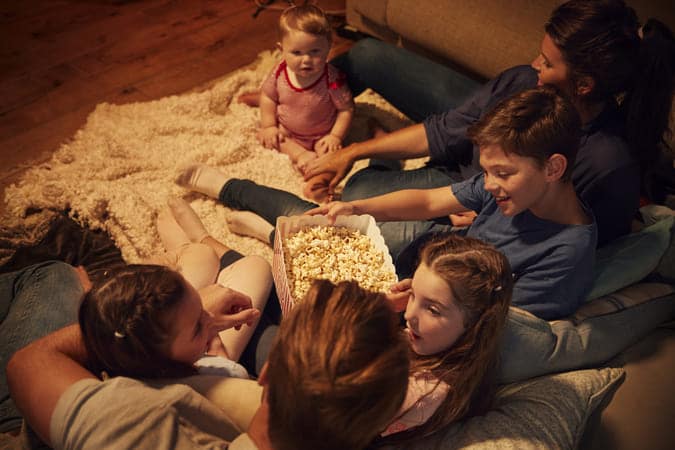The 1990s were a unique time for parents, with significant differences in parenting styles and approaches compared to today. Many memorable trends and cultural events shaped the way parents raised the teen years of their children during this decade. From embracing new technology to rethinking traditional views on discipline, parenting in the 90s was a time of transition and experimentation.
In this article, we take a nostalgic look back at parenting in the 90s, a unique and transitional time characterized by evolving parenting styles and the growing influence of technology and media on family life.
Understanding Parenting in the 90s
The Nostalgic 90s
Back in the 90s, house, and family life had a certain charm. Parents managed to keep their children entertained and educated despite the limited technological advancements that we are accustomed to today. Nostalgia seeps through when reminiscing about life in the days of yore.
Parenting styles and disciplinary tactics also experienced changes in the 1990s. Many parents began to move away from strict authoritarian approaches, opting for more collaborative and communicative strategies. This shift contributed to a generation of children who experienced a balance of structured guidance and newfound independence.
Technology on Family Life
One major aspect of parenting during this time was the influence of media and technology on family life. Childhood was filled with games that didn’t rely on technology, and spending quality time together bonded families.
As televisions and video games became more prevalent in households, parents had to navigate the challenges of setting limits and encouraging a balance between screen time and real-life experiences.
Additionally, the 90s saw the beginning of cell phone usage, forcing parents to decide when their children should be introduced to this new form of communication.
As a result, every family member had a pair for all occasions, and they just seemed to add an extra layer of comfort and style to their lives.
Family Interactions
Families usually had more face-to-face interactions around the dinner table. Instead of being glued to screens, as is common today, parents and children would engage in conversations like:
- Talking about their day.
- Sharing stories or jokes.
- Truly connecting with one another.
Back then, there were cameras with physical rolls of film to capture precious memories. These photographs turned into cherished keepsakes of unforgettable moments.
Navigating the World Without Social Media
Another important aspect of 90s parenting was the lack of social media pressure. Parents were more focused on their actual relationship with their children rather than trying to create an unrealistic facade for online followers. Additionally, children did not experience the onslaught of peer comparison and bullying that is rampant on social media today among today’s kids.
One can’t help but feel nostalgic about the simpler parenting times in the 90s. The atmosphere was more relaxed, and family life centered on closeness and strong communication.
Even though technology has made life better in many ways in today’s society, people still miss the close family bonds and simple times before social media, back when overalls were in style.
Media and Technology Influence
Social Media Influence
In the 90s, social media wasn’t as prevalent as it is today. Platforms like Instagram and TikTok didn’t exist, so parents didn’t have to worry about their kids being constantly exposed to various online content.
Nowadays, with various social media platforms at their disposal, children are more likely to be influenced by the online environment. Parents must be cautious about their children’s social media use and monitor it to ensure they’re not exposed to inappropriate content.
Role of Movies and Netflix
Back in the ’90s, movies and television shows had a significant influence on children’s lives, but their access to this media was more limited compared to the present.
With streaming platforms like Netflix, children today have an endless variety of shows and films to watch at their fingertips. Therefore, parents must be careful to regulate screen time and make sure their kids are viewing age-appropriate content.
Impact of Google and YouTube
For the most part, during the ’90s, children didn’t have the privilege of searching for information with the click of a button. Nowadays, with the advent of technology, particularly the internet and platforms like Google and YouTube, children have a world of information at their fingertips.
The 90s had its distinct parenting quirks and joys. But how does it compare to other eras? Check out our article on different parenting styles to see how approaches have evolved over time.
Parenting Styles and Discipline in the 90s
Parental Roles
In the 90s, parental roles were more defined, with moms and dads taking on specific responsibilities within the household. Mothers were often the primary caregivers, while fathers were seen as the providers and disciplinarians. Despite the apparent rigidity of these roles, many parents in the 90s strived to strike a democratic parenting approach.
What is Democratic Parenting?
A style characterized by mutual respect between parent and child. The idea was to be firm, yet kind, respecting both the rights and limits of the parent and the child. In this approach, parents value open communication and encourage their child’s independence while also providing course guidance and support.
Discipline Approaches
Discipline in the 90s varied among households, but some common approaches stand out:
Spanking: People widely accepted this physical form of discipline in the 90s more than they do today. Parents would spank their children as a form of punishment, with the intent to instill fear and discourage undesirable behavior.
Time-outs: Time-outs involve removing the child from a situation. Then placing them in a designated spot to think about their actions that certain night and the consequences of their choices.
Loss of privileges: Parents would often take away privileges, like watching TV or playing with a favorite toy. This can be a means of teaching responsibility and showing that actions have consequences. (e.g., if a child refused to wear a coat on a cold day, they would learn to deal with the uncomfortable outcome).
Anger management: Experts often advise parents to manage their anger and refrain from lashing out at their children. This helped create an environment where children felt safe to express their feelings and learn from their mistakes.
Through a combination of these discipline approaches, parents in the 90s sought to teach their children valuable life lessons while fostering a sense of independence, responsibility, and respect for boundaries.
Below is a table summarizing some key differences and similarities between parenting in the 90s and parenting kids today:
| Aspect | Parenting in the 90s | Parenting Today |
|---|---|---|
| Technology | Emergence of video games, cell phones | Ubiquitous smartphones, social media |
| Parenting Styles | Shift towards more open communication | Continuation of open communication |
| Disciplinary Methods | Time-outs, loss of privileges, spanking | Time-outs, loss of privileges, emphasis on conversation and understanding |
| Family Interaction | Family dinners, less screen time | Challenge to balance screen time and family time |
| Social Media Influence | Not applicable | Significant impact on children and parents |
| Fashion | Emergence of stylish maternity wear | Variety of maternity fashion options |
| Challenges | Managing new technology, changing parenting styles | Balancing technology, social media pressures, and parenting |
Childhood Experiences in the 90s

Snacks and Lunch Highlights
In the ’90s, opening a lunchbox often revealed surprising, iconic treats, filling children with joy. But it wasn’t all about pre-packaged snacks. Those who had lunch money to spend often went for cafeteria classics like pizza or hotdogs. While people might not have prioritized nutrition, they still cherish the memories of those delectable delights today.
Some of the favorite snacks back in the day are:
- Dunkaroos: Dunk crispy cookies into mouth-watering frosting
- Lunchables: Children can assemble their own mini crackers, cheese slices, and ham
The Rise of Extracurricular Activities
Parents started to emphasize the importance of their children participating in extracurricular activities. These activities became a fun way to fill free time and enabled children to discover new hobbies and passions.
- Sports teams: Athletic sports, like soccer and basketball, became a staple in many kids’ daily schedules, offering them an opportunity for physical exercise and team bonding.
- Playdates: This provides kids with ample opportunities to socialize outside of the school setting.
- Get-togethers: These are often with neighbors or classmates, two girls, and children who could explore their interests and friendships.
Transitioning from the 90s

Screen Time and its Effects
Back in the day, children’s screen time mostly revolved around watching TV and playing video games on consoles.
Parents weren’t as concerned about setting strict limits on screen time, as it was then a relatively new phenomenon. However, today’s parents are more aware of the potential negative effects of excessive screen time on their kids’ physical, mental, and social development.
As research on the impact of screen time on children has widely expanded, parents now have guidelines to follow and are strongly encouraged to set boundaries for their kids to limit screen time and use. This includes:
- Setting rules around homework completion
- Encouraging other forms of entertainment (i.e., reading and outdoor play)
The Advent of Cell Phones
The widespread use of cell phones has also significantly changed parenting since the 90s. Back then, children typically did not have their own cell phones, and contacting friends or family involved using landlines. Nowadays, even young children have access to cell phones and other devices with internet connectivity.
This shift in technology affects both parents and children in various ways.
For instance, parents can now track their kids’ location and communicate with them more efficiently. Yet, the concern over internet safety, along with kids potentially becoming too reliant on technology, requires parents to navigate this new landscape cautiously.
Balancing the advantages and potential risks, parents are faced with the challenge of maintaining a healthy, tech-savvy environment for their children.
90s Maternity Fashion Trends

In addition to mobiles and phones, maternity fashion also underwent a significant transformation in the 90s era.
As public and media interest in pregnant celebrities increased, there was a growing awareness of maternity style. This marked the beginning of stylish and chic maternity wear for expectant mothers.
One of the most iconic maternity fashion moments in the 90s was Demi Moore’s nude pose on the cover of a magazine, which helped break the stigma around pregnancy and embracing one’s body. As you can see, celebrities played a significant role in popularizing these fashion trends, and many women began to emulate their maternity styles.
Iconic Moments and Trends
- Adoption of athletic wear and low-rise jeans for maternity fashion
- The popularity of bright colors and bold patterns in maternity wear
- Some expectant mothers opted for loose-fitting dresses
- Others embraced more form-fitting options that highlighted their growing bellies
Special 90s Family Moments

Movie Nights
In the 90s, family movie nights often meant renting VHS tapes from the local video store. With no streaming services, parents and kids enjoyed picking out their favorite movies and huddling around the TV. Meanwhile, board games were also a popular activity, as families bonded over kid-classic games such as:
- Monopoly
- Scrabble
- Chess
Furthermore, Barney the Dinosaur was a prominent figure during this time, with many parents suffering through countless hours of episodes of the TV show to entertain their children. For some, the vibrant purple dinosaur was a fond memory of family time, while others may still shudder at the thought.
Road Trips
Road trips in the 90s were a quintessential family experience. Kids often slept in the back of the station wagon, while parents navigated using large, folded paper maps.
With no smartphones or tablets, families relied on playing activities like:
- Alphabet Game
- Singing 90s theme song
- Telling stories to pass the time
The Tooth Fairy also played an entertaining role during these trips, with parents secretly leaving coins under their children’s pillows in exchange for lost teeth. These were the days before tracking apps, and parents had to exercise their creativity to keep the magic alive.
Frequently Asked Questions
How did parenting styles differ in the 90s?
In the 90s, many parents began to move away from the autocratic styles of parenting that were common among previous generations. Today, parents try to avoid spanking, threats, humiliation, and excessive punishment, striving for a more nurturing and understanding approach to raising their children.
What were the popular toys and activities for kids in the 90s?
Popular toys and activities for kids in the 90s included playing with physical toys like:
- Action figures
- Dolls
- Board games
- Video game consoles (i.e., Nintendo 64 and PlayStation 1)
How has technology impacted parenting since the 90s?
Parents now need to navigate issues related to managing screen time, monitoring online content, and dealing with social media pressures.
What were common disciplinary methods used by parents in the 90s?
Some of the common disciplinary methods used by parents in the 90s include:
- Time-outs
- Loss of privileges
- Occasionally spanking
How did family dynamics change from the 90s to the 2000s?
Many families now have both parents working full-time, leading to increased reliance on childcare services and after-school activities. Parents also need to balance their children’s growing dependence on technology with real-life experiences and interactions.
What Are the unique challenges for 90s parents compared to today?
Parents in the 90s faced unique challenges, such as a lack of information on the internet and a more limited range of products and resources for child-rearing. However, they also enjoyed a sense of freedom from the constant monitoring and comparison that today’s parents often face due to social media and the internet.
Wrapping Up – ADOPTING PARENTING LESSONS FROM 90S GENERATION
As we take a trip down memory lane, we are reminded of the unique essence that encapsulates parenting in the 90s. This era was characterized by its evolving parenting styles, the initial burst of technology and media influence, and the special family moments that were unburdened by today’s digital age distractions.
While technology has undoubtedly improved our lives in numerous ways, there’s something to be said about the authentic family connections and simplicity that defined the 90s. As we become a part of the 90s kids, we can continue to navigate the complexities of modern parenting. Overall, let’s not forget the valuable lessons and memories that the 90s parents’ generation has left us with.






